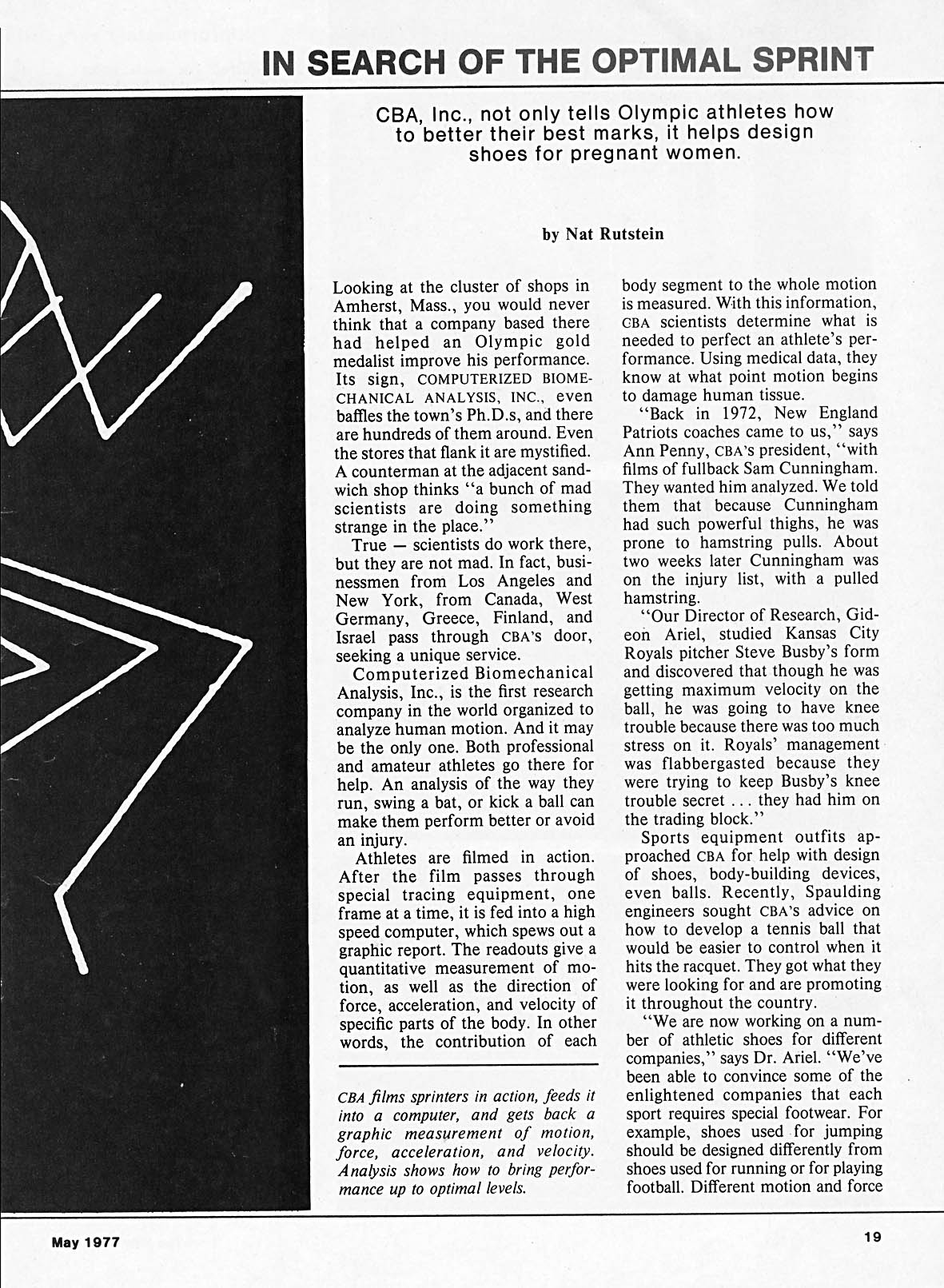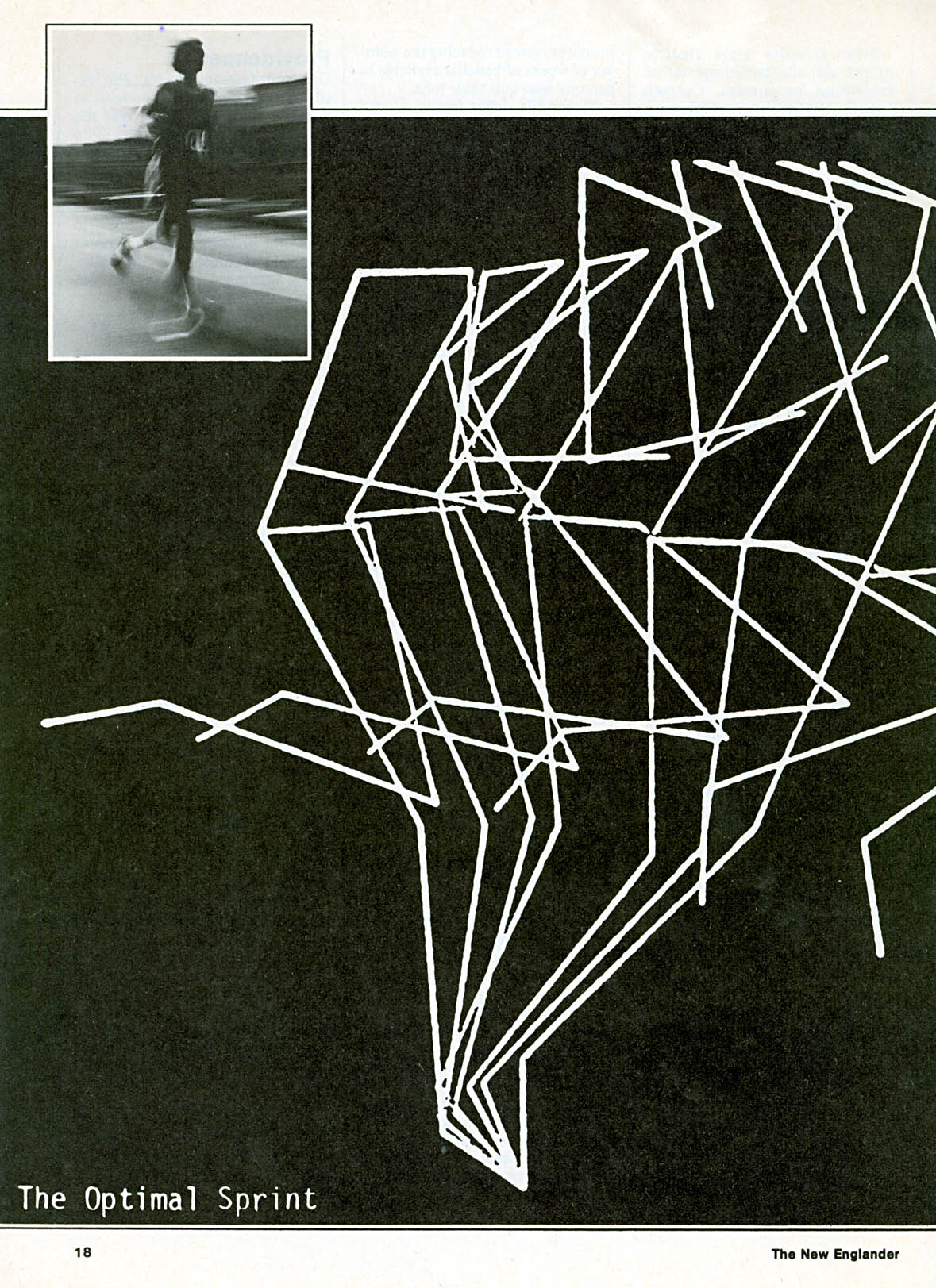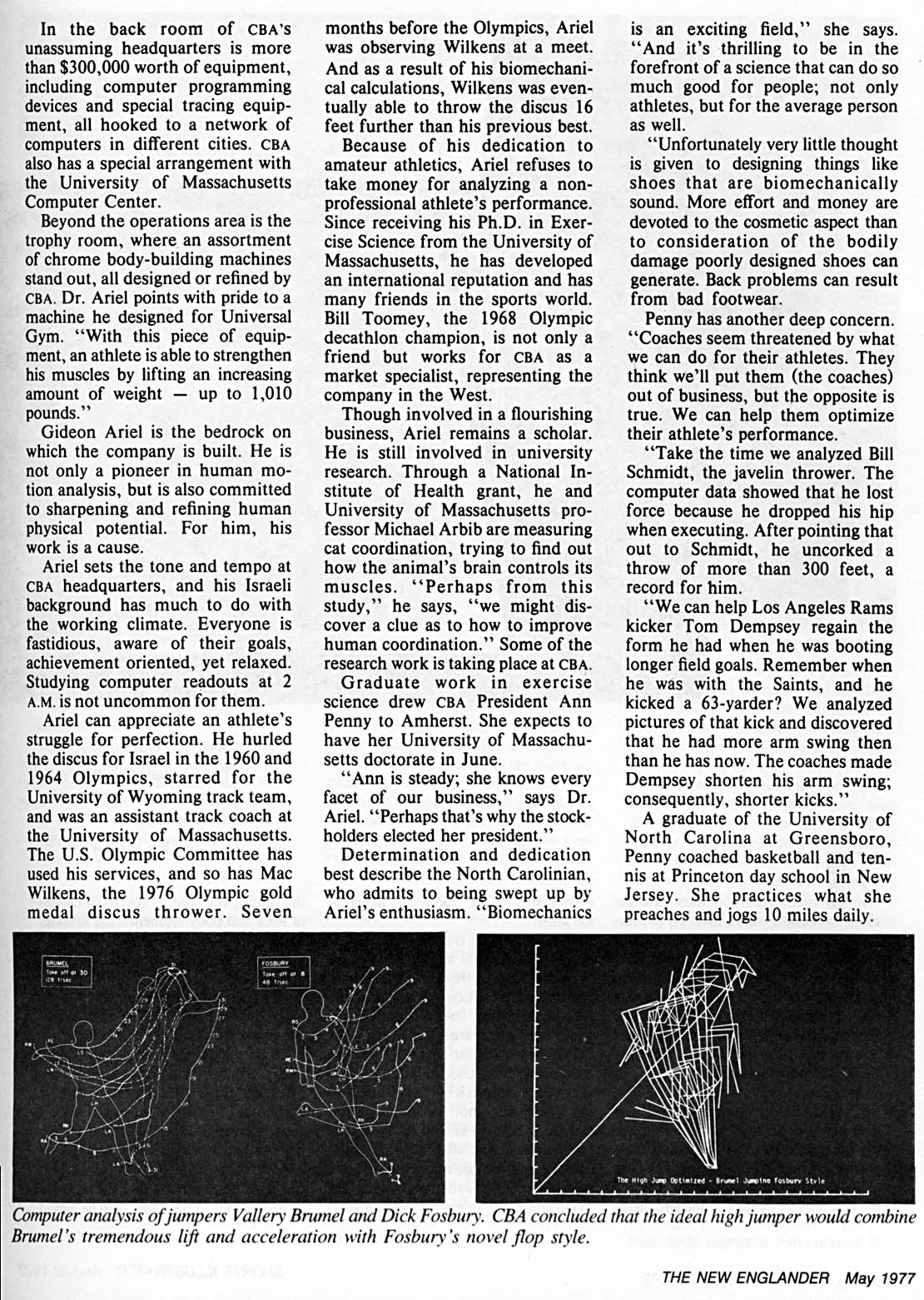In Search of The Optimal Sprint
CBA, Inc. not nly tells olympic Athletes how to better their best marks, but much more.
By Nat Rustein in The New Englander on Wednesday, January 5, 1977
CBA: Pioneers in Human Motion Analysis
This article discusses the work of Gideon Ariel and his company, CBA, in the field of human motion analysis. Ariel, a former Olympian and pioneer in biomechanics, has dedicated his career to refining human physical potential. His company, CBA, uses advanced technology and equipment worth over $300,000 to analyze and improve athletic performance.
CBA's work extends beyond athletics, with a focus on designing biomechanically sound products, such as shoes. The company's president, Ann Penny, emphasizes the importance of this aspect of their work, noting the potential for poorly designed shoes to cause bodily damage.
The article also highlights the company's collaborative efforts with the University of Massachusetts Computer Center and the National Institute of Health. These partnerships allow CBA to conduct research aimed at improving human coordination and athletic performance.
Despite the company's success, Ariel remains committed to supporting amateur athletics and refuses to charge nonprofessional athletes for performance analysis. The article concludes by highlighting the dedication and enthusiasm of the CBA team, which includes former athletes, computer programming experts, and engineering professionals.
Tip: use the left and right arrow keys
"Unfortunately very little
is required for each sport .... Ideally, each athlete's shoe should be custom-made because everyone is different."
In the back room of CBA's unassuming headquarters is more than $300,000 worth of equipment, including computer programming devices and special tracing equipment, all hooked to a network of computers in different cities. CBA also has a special arrangement with the University of Massachusetts Computer Center.
Beyond the operations area is the trophy room, where an assortment of chrome body-building machines stand out, all designed or refined by CBA. Dr. Ariel points with pride to a machine he designed for Universal Gym. "With this piece of equipment, an athlete is able to strengthen his muscles by lifting an increasing amount of weight - up to 1,010 pounds."
Gideon Ariel is the bedrock on which the company is built. He is not only a pioneer in human motion analysis, but is also committed to sharpening and refining human physical potential. For him, his work is a cause.
Ariel sets the tone and tempo at CBA headquarters, and his Israeli background has much to do with the working climate. Everyone is fastidious, aware of their goals, achievement oriented, yet relaxed. Studying computer readouts at 2 A.M. is not uncommon for them.
Ariel can appreciate an athlete's struggle for perfection. He hurled the discus for Israel in the 1960 and 1964 Olympics, starred for the University of Wyoming track team, and was an assistant track coach at the University of Massachusetts. The U.S. Olympic Committee has used his services, and so has Mac Wilkens, the 1976 Olympic gold medal discus thrower. Seven months before the Olympics, Ariel was observing Wilkens at a meet.
Research Director Gideon Ariel (top) with a machine designed to test shoes. (middle) Computer analysis of jumpers Vallery Brumel and Dick Fosbury. CBA concluded that the ideal high juniper would combine Brumel 's tremendous lift and acceleration with Fosbury's novel flop style (bottom).
The New Englander
thought is given to designing shoes that are biomechanically sound."
And as a result of his biomechanical calculations, Wilkens was eventually able to throw the discus 16 feet further than his previous best.
Because of his dedication to amateur athletics, Ariel refuses to take money for analyzing a nonprofessional athlete's performance. Since receiving his Ph.D. in Exercise Science from the University of Massachusetts, he has developed an international reputation and has many friends in the sports world. Bill Toomey, the 1968 Olympic decathlon champion, is not only a friend but works for CBA as a market specialist, representing the company in the West.
Though involved in a flourishing business, Ariel remains a scholar. He is still involved in university research. Through a National Institute of Health grant, he and University of Massachusetts professor Michael Arbib are measuring cat coordination, trying to find out how the animal's brain controls its muscles. "Perhaps from this study," he says, "we might discover a clue as to how to improve human coordination." Some of the research work is taking place at CBA.
The strapping Israeli stays in shape by playing paddle ball and lifting weights. That is not always easily done because Ariel might be negotiating a sports equipment deal in Berlin on Monday and addressing a sports medicine convention in New Orleans on Thursday.
Graduate work in exercise science drew CBA President Ann Penny to Amherst. She expects to have her University of Massachusetts doctorate in June.
"Ann is steady; she knows every facet of our business," says Dr. Ariel. "Perhaps that's why the stockholders elected her president."
Determination and dedication best describe the North Carolinian, who admits to being swept up by Ariel's enthusiasm. "Biomechanics is an exciting field," she says. "And it's thrilling to be in the forefront of a science that can do so much good for people; not only athletes, but for the average person as well.
"Unfortunately very little thought is given to designing things like shoes that are biomechanically sound. More effort and money are devoted to the cosmetic aspect than to consideration of the bodily damage poorly designed shoes can generate. Back problems can result from bad footwear. And consider the poor pregnant woman who wears conventional shoes."
Penny has another deep concern. "Coaches seem threatened by what we can do for their athletes. They think we'll put them (the coaches) out of business, but the opposite is true. We can help them optimize their athlete's performance.
"Take the time we analyzed Bill Schmidt, the javelin thrower. The computer data showed that he lost force because he dropped his hip when executing. After pointing that out to Schmidt, he uncorked a throw of more than 300 feet, a record for him.
"We can help Los Angeles Rams kicker Tom Dempsey regain the form he had when he was booting longer field goals. Remember when he was with the Saints, and he kicked a 63-yarder? We analyzed pictures of that kick and discovered that he had more arm swing then than he has now. The coaches made Dempsey shorten his arm swing; consequently, shorter kicks."
A graduate of the University of North Carolina at Greensboro, Penny coached basketball and tennis at Princeton day school in New Jersey. She practices what she preaches and jogs 10 miles daily.
"Like the mailman," Ariel laughs, "she's out on the road in the heat, rain, snow, and sleet every day."
CBA's senior computer programmer, Allan Blitzblau, says he gets his exercise shoveling goat manure out of his barn, splitting wood, and occasionally playing paddle ball.
"Al's a computer programming wizard," says Ariel. "He takes my data and puts it into a useful form so our chief engineer can design the proper tests and machines."
Blitzblau, a Brown University honor student, came to the University of Massachusetts to work at the computer center as a systems programmer. He still works there halftime. But his first love is CBA.
"What I'm doing," he says, "is exciting. Everyday there's a new challenge. It is the most creative work I've ever done." The tall, slim man smiles and adds, "Besides, the atmosphere here is great ... we are like a loving family."
When asked why he hasn't pursued his doctorate, the 30-year-old Schenectady, New York, native says, "I'm happy with what I'm doing ... I'd go for a Ph.D. if I had nothing else to do."
Blitzblau lives with his wife and three children in a small house in the woods of Shutesbury, a hamlet 10 miles from CBA.
Chief engineer Paul Tartaglia never dreamed of working in biomechanics. This former University of Massachusetts engineering professor earned his Ph.D. from the University of Detroit, planning on a life of designing industrial machinery or lecturing to college students.
"Thanks to Ariel," he says, "I'm in a rapidly expanding field with a great scientific breakthrough opportunity."
Tartaglia does not miss Long Island, where he grew up. "I like to hunt and fish, and I enjoy country living. Amherst has all of that, and being a university town, it attracts great artists and thinkers. It has the best of both worlds."
Though Ariel, Blitzblau, Penny, and Tartaglia perform special functions, there is an overlapping of duties, with one exception: no one treads on Blitzblau's domain. "Al," Tartaglia says, "is a computer programming artist."
There is an air of informality at CBA. Penny is usually dressed in jeans and a sweater, and the only one who wears a tie is Chairman of the Board and Treasurer Larry Graham, a 55-year-old business veteran whose executive credentials would impress even Wall Street wizards.
Graham is also chairman of the board of Hampshire National Bank, based in Northampton (Mass.), president of Holyoke Hospital, and former president of Graham Manufacturing Company, which produces paper products for the medical field. After selling the company, Graham bought two other businesses (one in New York, the other in Florida), sold them for a profit, and then purchased 35% of CBA's stock.
Graham, who commutes from
May 1977
In the back room of CBA's unassuming headquarters is more than $300,000 worth of equipment, including computer programming devices and special tracing equipment, all hooked to a network of computers in different cities. CBA also has a special arrangement with the University of Massachusetts Computer Center.
Beyond the operations area is the trophy room, where an assortment of chrome body-building machines stand out, all designed or refined by CBA. Dr. Ariel points with pride to a machine he designed for Universal Gym. "With this piece of equipment, an athlete is able to strengthen his muscles by lifting an increasing amount of weight - up to 1,010 pounds."
Gideon Ariel is the bedrock on which the company is built. He is not only a pioneer in human motion analysis, but is also committed to sharpening and refining human physical potential. For him, his work is a cause.
Ariel sets the tone and tempo at CBA headquarters, and his Israeli background has much to do with the working climate. Everyone is fastidious, aware of their goals, achievement oriented, yet relaxed. Studying computer readouts at 2 A.M. is not uncommon for them.
Ariel can appreciate an athlete's struggle for perfection. He hurled the discus for Israel in the 1960 and 1964 Olympics, starred for the University of Wyoming track team, and was an assistant track coach at the University of Massachusetts. The U.S. Olympic Committee has used his services, and so has Mac Wilkens, the 1976 Olympic gold medal discus thrower. Seven months before the Olympics, Ariel was observing Wilkens at a meet. And as a result of his biomechanical calculations, Wilkens was eventually able to throw the discus 16 feet further than his previous best.
Because of his dedication to amateur athletics, Ariel refuses to take money for analyzing a nonprofessional athlete's performance. Since receiving his Ph.D. in Exercise Science from the University of Massachusetts, he has developed an international reputation and has many friends in the sports world. Bill Toomey, the 1968 Olympic decathlon champion, is not only a friend but works for CBA as a market specialist, representing the company in the West.
Though involved in a flourishing business, Ariel remains a scholar. He is still involved in university research. Through a National Institute of Health grant, he and University of Massachusetts professor Michael Arbib are measuring cat coordination, trying to find out how the animal's brain controls its muscles. "Perhaps from this study," he says, "we might discover a clue as to how to improve human coordination." Some of the research work is taking place at CBA.
Graduate work in exercise science drew CBA President Ann Penny to Amherst. She expects to have her University of Massachusetts doctorate in June.
"Ann is steady; she knows every facet of our business," says Dr. Ariel. "Perhaps that's why the stockholders elected her president."
Determination and dedication best describe the North Carolinian, who admits to being swept up by Ariel's enthusiasm. "Biomechanics is an exciting field," she says. "And it's thrilling to be in the forefront of a science that can do so much good for people; not only athletes, but for the average person as well.
"Unfortunately very little thought is given to designing things like shoes that are biomechanically sound. More effort and money are devoted to the cosmetic aspect than to consideration of the bodily damage poorly designed shoes can generate. Back problems can result from bad footwear.
Penny has another deep concern. "Coaches seem threatened by what we can do for their athletes. They think we'll put them (the coaches) out of business, but the opposite is true. We can help them optimize their athlete's performance.
"Take the time we analyzed Bill Schmidt, the javelin thrower. The computer data showed that he lost force because he dropped his hip when executing. After pointing that out to Schmidt, he uncorked a throw of more than 300 feet, a record for him.
"We can help Los Angeles Rams kicker Tom Dempsey regain the form he had when he was booting longer field goals. Remember when he was with the Saints, and he kicked a 63-yarder? We analyzed pictures of that kick and discovered that he had more arm swing then than he has now. The coaches made Dempsey shorten his arm swing; consequently, shorter kicks."
A graduate of the University of North Carolina at Greensboro, Penny coached basketball and tennis at Princeton day school in New Jersey. She practices what she preaches and jogs 10 miles daily.
Computer analysis of jtunpers Val/ery Bnonel and Dick Fosbun% CBA concluded that the ideal high jumper would combine Brumel's tremendous lift and acceleration with Fosbunv's novel flop stYle.
THE NEW ENGLANDER May 1977






